Classic Fish Cakes
This post may contain affiliate links. See my disclosure policy.
Delightfully crispy on the outside, tender, moist and flaky on the inside, this BEST fish cakes recipe is the perfect way to enjoy fish, even for those who are picky about eating seafood! Paired with my homemade tartar sauce these fish cakes are sure to be a smash hit!
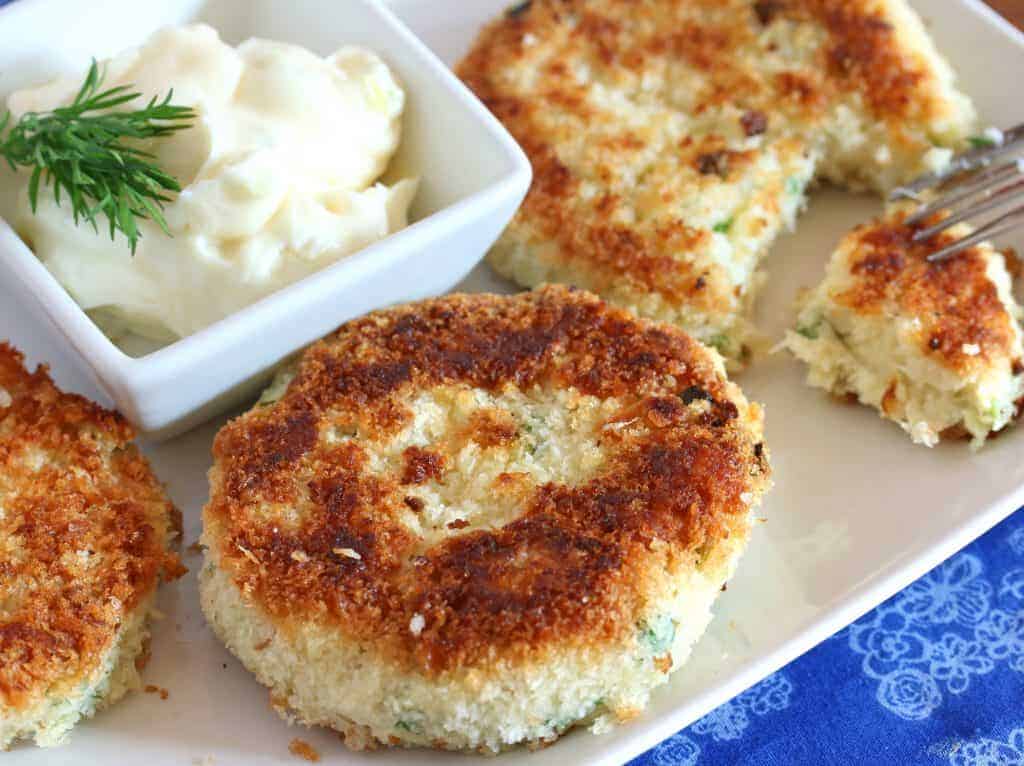
The BEST Homemade Fish Cakes
Fish cakes in various forms are eaten throughout the world and have a long history, dating back to ancient China nearly 4000 years ago. Every country has its own variation but the classic Western ones consists of fish, potatoes, eggs, onions, seasoning, herbs and often breadcrumbs. Through the years they also became a convenient way to use up leftovers. Mrs. Beeton’s 19th century recipe calls for “leftover fish” and “cold potatoes,” a great example of repurposing food. Since those times fish cakes have risen to new horizons, even being served in upscale restaurants with modern twists and gourmet ingredients like smoked salmon and truffles.
These patties are a great way to enjoy fish if you’re generally not crazy about it. The other ingredients help camouflage the flavor, especially if you’re using a mild white fish like cod or haddock, and even the pickiest of eaters may surprise you when you serve these.
Today I’m making some good old-fashioned, classic fish cakes inspired by our excursions up through New England that will have you coming back for seconds, especially when you serve them with our BEST Homemade Tartar Sauce!


BEST Fish Cakes Recipe
Let’s get started!
Place all ingredients, except for the breadcrumbs, in a large bowl and mash until thoroughly combined.
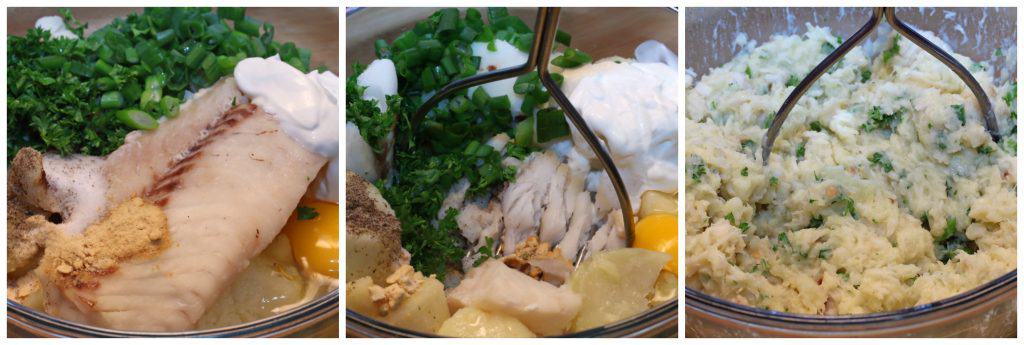
Form the mixture into patties and roll them in the panko breadcrumbs.
Refrigerate the patties for at least 30 minutes or until they’ve firmed up.
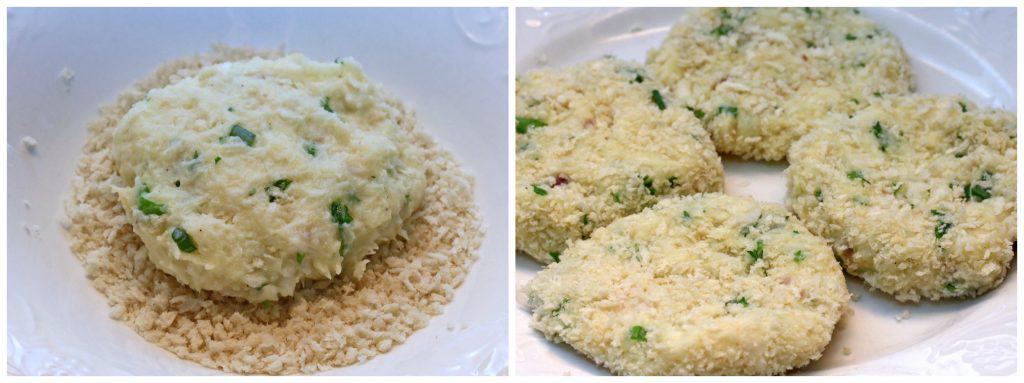
Heat some oil in a non-stick pan and fry the patties on each side for 3-4 minutes until lightly browned, being careful not to overcrowd the pan.
Serve these fish cakes immediately with my BEST Homemade Tartar Sauce.
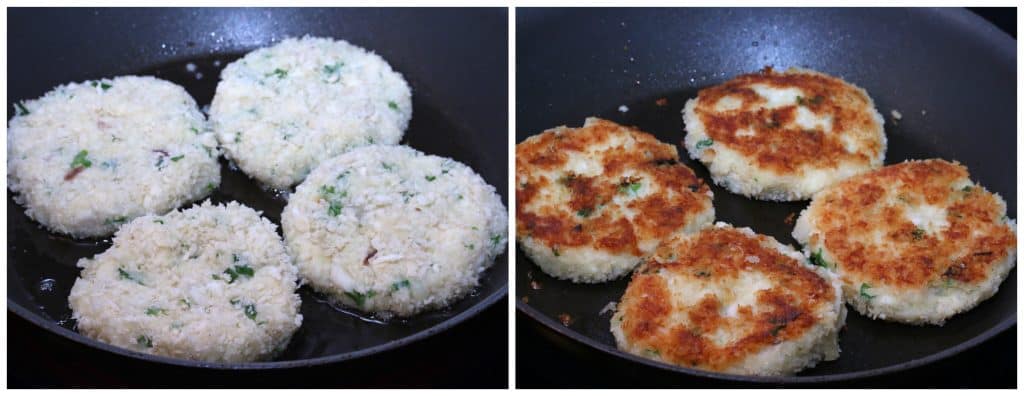
Can Fish Cakes Be Reheated?
Yes. They’re crispiest when they’re straight out of the frying pan but if you have leftover cooked fish cakes you can reheat them in the oven. They can also be microwaved but they’ll be soggier that way.
Can You Freeze Fish Cakes?
Yes, they’re perfect for freezing! Fully assemble the fish cakes, place them in a single layer on a lined baking sheet and freeze them. Once frozen you can put them in a freezer container with greaseproof paper between each layer. To cook them, simply thaw and cook and instructed. You’ll have an easy dinner in a hurry! These will keep for up to 3 months in the freezer.
Enjoy!
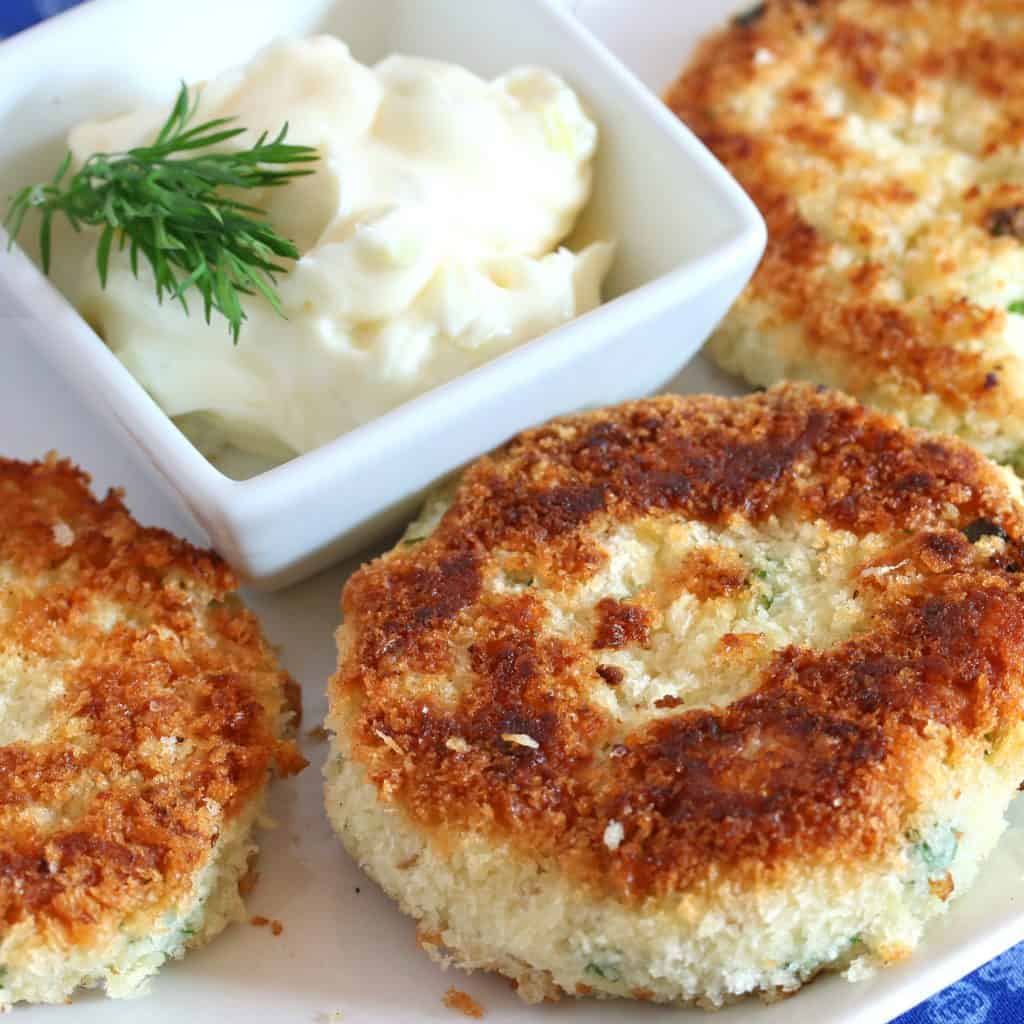
Save This Recipe
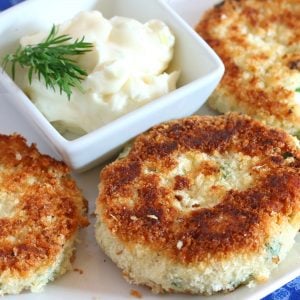
Classic Fish Cakes
Ingredients
- 2 large potatoes (about 2 cups mashed), diced, boiled and drained
- 1 pound white-fleshed fish, COOKED (cod, haddock, pollock, halibut, flounder)
- 1 large egg
- 3 tablespoons sour cream
- 2 tablespoons butter, softened
- 2 green onions, sliced
- 3 tablespoons chopped fresh parsley
- 1 teaspoon sea salt
- 1/4 teaspoon freshly ground black pepper
- 1/2 teaspoon dry ground mustard
- panko breadcrumbs , for coating
- (Gluten-free use GF panko breadcrumbs)
- oil for frying
- Homemade Tartar Sauce
Instructions
- Place all ingredients, except for the breadcrumbs, in a large bowl and mash until thoroughly combined.Form the mixture into 8 equal patties and roll them in the panko breadcrumbs. (You can make smaller patties if you prefer.) Refrigerate the patties for at least 30 minutes or until they've firmed up.
- Heat some oil in a non-stick pan and fry the patties on each side for 3-4 minutes until lightly browned, being careful not to overcrowd the pan.
- Serve immediately with our BEST homemade tartar sauce!
Notes
- To save time, cook the fish and potatoes in advance then mash the ingredients together when you’re ready to make the fish cakes.
Nutrition
Originally published on The Daring Gourmet November 2, 2017



















These were delicious. I didn’t have sour cream so it was omitted. Instead of green onions, I used fresh chives from my garden…same flavour. On the east coast of Canada, we eat fish cakes with baked beans…a fantastic pairing. Thank you for the fantastic recipe.
Thanks so much for the feedback, C, I’m thrilled you enjoyed them!
Hi , enjoyed the recipe. added one extra tablespoon butter instead of sour cream or yogurt due to lactose intolerance. Added 2 table spoons homemade Chimmicurri sauce to mixture for moisture and flavor. Was so delicious. Serived with Coleslaw made with Horseradish Dill sauce. (Like Tarter but lighter) Thanks for all.
This comment comes from South Africa. I used a local fish called Yellowtail, a gift and definitely not my favourite. It is a firm, darkish fish which is most often barbequed (or braaied, as we say) in this country. I sealed the fish in an aluminium parcel with onions, lemons, and butter and cooked it in the oven.
Using this recipe, I managed to make the best fish cakes I have ever produced. Made eight, froze four and shared both lots with two different friends. Both confirmed that they were the best, so thank you for that.
PS: I found your explanation of green onions vs scallions helpful. We also refer to scallions as spring onions here.
That’s fantastic, Jennifer, I’m so glad you found a delicious use for the yellowtail! I’m thrilled you enjoyed these fish cakes and appreciate the feedback!
In the ingredients it says cooked fish, does that mean it must be cooked prior to adding to the mixture? Sorry if this is a dumb question.
Hi Oksana, yes that is correct, the fish should be cooked in advance prior to adding it to the mixture. Happy cooking!
Can only be improved by added lots of fresh dill.
Is there a substitute for the sour cream. My diet will not allow it. Thx,
Helen
Hi Helen, you can use Greek yogurt if you prefer.
Can I add some flour if the mix is too wet
Hi Ann, yes you can, or you can add some more breadcrumbs.
I’m wondering why there is no measurement for the Panko bread crumbs?
5 stars. Will keep in supper rotation. My picky son loves them and we all enjoyed your recipe more than the older recipe I was using. Thank you for sharing. And to those people who complained about the linguistics, really? You have an excellent recipe to eat and you are going to argue semantics? Cook the recipe and enjoy the food.
Thank you, Mary, I’m so happy it was a family hit! <3
Have prepared mix a little loose would adding 1/4 cup bread crumbs be ok ,the mix smells great ,used smoked cod and small amount of marina mix ,thanks for your great recipes
Hi John, if won’t hold together in patties you can add some more mashed potatoes and, if you need to, some more breadcrumbs too. Happy cooking! :)
Hi,
I put the ingredients in the nutri-bullet to mash up. The mixture came out quite runny. any idea how to make it firmer to mould into balls?
Hi Scott, I recommend mashing it by hand to prevent over-mashing it (which will make the texture runnier). In the event that it’s still a little runny you can add some extra mashed potato.
This recipe (and the sauce) has became one of our favorite recipe during this time. So good! The only thing I’d change is the prep time… it takes me a while to make everything. Also, I do the purée and the fish in advance, as the patties stick together better when everything is cold. Thanks for this recipe !!
I’m so glad you enjoyed it, Mathilde, thanks so much for the feedback!
Please learn what Gourmet actually means.
It is just used as a meaningless snob term in America. American’s have no idea what Gourmet actually means, other than an extortionate price tag for no good reason other than bragging about it.
“Gourmet” is French (Pronounced ‘Gormay’), it means a Chef that is also your Waiter.
Ironically, that greasy 2 bit cockroach dinner that you go to where the chef is also the person serving you… that is what “Gourmet” actually means.
Pepé, I would ask you to do the same. Please learn the standard definition of the noun “gourmet” as used not only in the U.S. but in the UK and English speaking world at large:
Cambridge dictionary: “A person who knows a lot about food and cooking, and who enjoys eating high-quality food. A connoisseur of good food; a person with a discerning palate.”
Oxford dictionary: “A person who knows a lot about good food and wines and who enjoys choosing, eating, and drinking them.”
Merriam Webster: “A connoisseur of food and drink.”
Macmillan dictionary: “Someone who knows a lot about good food and wine.”
FYI: The word “gourmet” comes from the 19th century French term referring to a “wine drinker.”
Kimberly, your definition sources given for “gourmet” come from marketing origins, in the same way that the current inappropriate ubiquitous labeling of “tea” does.
Society is so easily manipulated and deceived by the marketing system, via “the dumb down effect”. All they want is our money in return for the consumers cheap bragging rights to impress people for 5 minutes.
Tea :
While marketing now calls everything “tea”, it is quite ironic that you need qualifications in English to get that job. What is in a definition ?
Only one plant ingredient is called Tea, Camellia sinensis. Everything else is technically called an “infusion of ….” or “a …herb… brew” (or simply just “a brew” when referring to actual Tea), it has been that way for millennia. Now Marketing want to change that just for sales.
e.g. “Mint tea” does not exist unless it also contains Camellia sinensis in the ingredients of the drink. The word “Tea” comes from Asia, it is what they called a medicinal drink that was made from Camellia sinensis. Given that Asia was the origin of Tea, maybe we should stick with their definition so that we are all on the same page.
Gourmet :
Is derived from Old French “gromet”, meaning “valet”, from the early medieval period if not older.
Indiscriminate use of the term “gourmet” in pretentious market advertising has rendered the term meaningless (as it has with “tea” and the word “awesome” or “traditional” etc.). A restaurant advertising itself as a place for “fine gourmet dining” is almost certain not to be.
Not sure that English dictionaries can be trusted with French translations given that France and the UK don’t like each other much. The quality of English dictionaries has also diminished in the past 2 decades.
The English say “Fillit” rather than “Filay” just in spite of the French.
Americans say “Pate” rather than “Patay”, “Nestle” rather than “Nestlay” etc.
It is the butchery and sabotage of language usually for insult or from general ignorance.
So, what is the big deal about destroying definitions ?
1. It makes the populace illiterate via “the dumb down effect”.
2. It can lead to accidents and/or death.
Say you have an allergy to nuts, You order a meal that does not have the ingredients of “nuts” listed. Problem is that, you did not know that somebody in marketing decided to call nuts by another word far removed from its actual definition. No use calling a nut a seed right ?
That can easily result in your death via the fatal allergic reaction due to a corrupt marketing definition.
3. Scientific laboratories never change description tags for good reason.
How can we communicate if we all start using random definitions for the same thing ?
Regarding your reply to Pepe :
FYI: “The word “gourmet” comes from the 19th century French term referring to a “wine drinker.”
You got that from Wikipedia. Wiki is not a credible source of information.
The word is traced back to at least the 13th century.
Kev, coming back to the topic at hand – the term “gourmet”….
I have supported my position by citing official publications (i.e., dictionaries) that are currently used and accepted in academia.
You and Pepe are basing your claims are on what what you say are “original” or older sources of the meaning of the word. I agree that original sources are vital in certain fields, such as history for example, or being able to understand things in context. However, when it comes to LANGUAGE, referring to language usage from centuries ago is completely moot and irrelevant if you’re trying to make an argument for how language is or should be used today. Language is fluid. Meanings change over time – they always have and they always will. If you take issue with how the word “gourmet” is used today in comparison to how it was used in the 13th century (for goodness sake!), then you might as well take issue with a very large portion of our vocabulary. Here are just a few examples to get you started and you can refer to the link below for more examples:
Nice: This word used to mean “silly, foolish, simple.” Far from the compliment it is today!
Silly: Meanwhile, silly went in the opposite direction: in its earliest uses, it referred to things worthy or blessed; from there it came to refer to the weak and vulnerable, and more recently to those who are foolish.
Naughty: Long ago, if you were naughty, you had naught or nothing. Then it came to mean evil or immoral, and now you are just badly behaved.
Awful: Awful things used to be “worthy of awe” for a variety of reasons, which is how we get expressions like “the awful majesty of God.”
Hussy: Hussy comes from the word housewife (with several sound changes, clearly) and used to refer to the mistress of a household, not the disreputable woman it refers to today.
https://ideas.ted.com/20-words-that-once-meant-something-very-different/
Wow… The “mansplaining” (I’d love to hear their feedback about that urban slang term that describes them perfectly) from Pepé & Kev was truly annoying & inappropriate. Talk about getting your panties in a bunch over terms that are arguably subjective. If they want to nit pick everything they can go find pupils & teach a class (doubtful they’re capable of holding anyone’s attention that long). Jesus Christ. Way to not let them push you around Kimberly!
Kev, you need a hobby.
One of the things Americans learn at a young age is to not say anything if you don’t have anything nice to say. I guess they don’t teach that where you’re from, little skunk? Here’s a tip: go find a productive hobby to engage in that will make you a more interesting person, instead of trying to make someone feel bad over a fish cake recipe on the internet.
Will try your recipe and let you know how they compare with my mom’s. Her recipe a little different. Thks.
Do you really use 2 onions? Seems like a lot. And why does it say sliced? Aren’t you supposed to dice them up and mix it in like it says?
Hi Grady, it’s not onions, it’s “green onions” :)
What is keeping all ingredients together
The egg and mashed potatoes.
Green Onions also called Scallions or Spring Onions in the UK. The difference between scallions, green onions and spring onions is age or the time they grow before being harvested. You can identify them by their bulb— scallions have the thinnest, usually no wider than the onion’s stem, while green onions’ bulbs are slightly larger and spring onions’ are round.